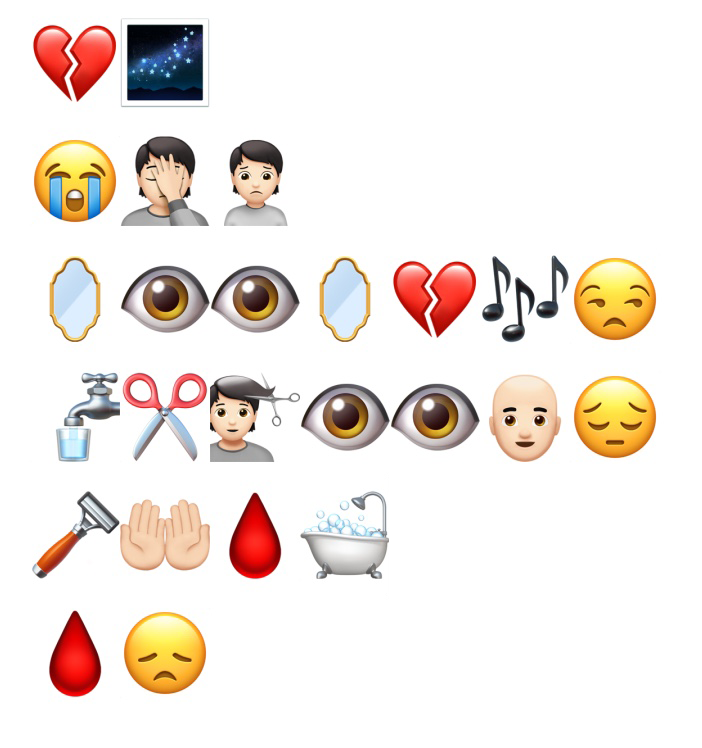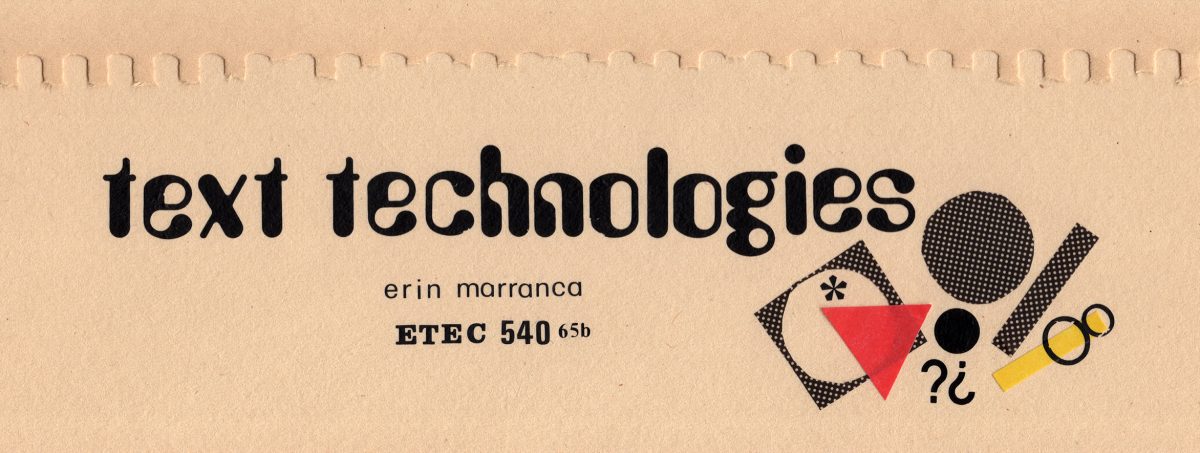
I had been contemplating using a particular film for the emoji story task and thought it would be a strong choice because of the overt and intentional symbolism the director uses in all their works. I began collecting the emojis that immediately came to mind. As my collection of emojis grew, I realized that although the symbols might identify the film to someone who knows it, they did not help with progressing the plot of the film. Initially, I assumed this issue was unique to my choice of film yet came to understand the problem was with the inherent nature of emojis or picture writing. Bolter (2001) explains, “By the standard of phonetic writing, however, picture writing lacks narrative power. The picture elements extend over a broad range of verbal meanings: each element means too much rather than too little” (p. 59). This is it – the breadth of meaning the emojis invoke is too extensive. For example, how do I explain, without words, the meaning of the bird in the film? A bald eagle might conjure ideas of America, or freedom, neither of which was my primary intent of using it. There is in fact a real bird in the film, and it isn’t even an eagle. Also, and without giving away the film, I’m not even sure I myself understand the meaning of the bird’s presence in the narrative, yet if I were attempting to provide an analysis, it would absolutely tie into the meaning of the other elements of them film, which are likewise vaguely represented without the use of words.
In addition to the problems with picture writing, the actual plot of the film was not clear; modern films don’t always adhere to a standard narrative structure. The film exists as a series of vignettes that reveal the depth of emotion and complexity of the characters, through which the plot progresses. There are four or five deeply memorable scenes: the lighting and colouring that creates the mood of the shot, the expressions on the actors’ faces, the tone of their voices, and the perfectly paired soundtrack. Regardless of the notable scenes, I had to watch the film again and jot down the plot in order to be able to recreate it in emojis. My tendency, especially on the key scenes, was to show the various minute changes in emotion, but continuing this would make my story incredibly long, so I streamlined it to keep it manageable. For example, I included a simplified version of this scene:

However, more emotionally and compositionally accurate attention to the same scene would look something like this:

Sure, the scene is about what happens, but it is also about the look in the character’s eyes. The way the eyes appear, looking back empty, yet filled with sorrow in the bathroom mirror are simply heartbreaking. The plot is acceptable, but it’s the attention to moments like this that make it such an iconic and significant film. See how much better I am describing it with words?
Concurrent to Bolter, Kress (2005) provides an explanation for the role of words, “Words are (relatively) empty entities—in a semiotic account they are signifiers to be filled with meaning rather than signs full of meaning, and the task of the reader is to fill these relatively vacant entities with her or his meaning. This is the task we call interpretation, namely interpreting what sign the writer may have intended to make with this signifier” (p. 56). After struggling with the emoji narrative, Kress’ description of words fills me with admiration: Words, those beautiful “empty entities” that you can sculpt and combine in infinite ways to say exactly what you need to say. But the attention to the necessity of “interpretation” reminds me that even with words, it’s hard to say exactly what you want to say. When considering images as “signs full of meaning”, and words as “empty entities” it seems as though we have two insufficient modes of communication. Perhaps this provides a clear explanation for why we use emojis in conjunction with text – it’s because they work so well together. Each compliments the other and together they provide further depth of meaning.
Reference List
Bolter, J. D. (2001). The breakout of the visual. Writing space: Computers, hypertext, and the remediation of print (2nd ed., pp. 47-76). Mahwah, N.J: Lawrence Erlbaum Associates. DOI:10.4324/9781410600110
Kress (2005), Gains and losses: New forms of texts, knowledge, and learning. Computers and Composition, Vol. 2(1), 5-22.

I don’t think I have seen the film, but I felt like it became much more real for me when I was reading your written description versus the picture writing. Even though the suicide scene is depicted very clearly with emoji writing, it did not evoke sympathy or any other emotional response in me whatsoever. On the other hand, when I read your paragraph about the character’s eyes, I got goosebumps… Agree that text and pictures work best in combination, even if their ratio is changed in modern hypertext.
Erin! Somehow I did not even THINK about separating my emojis into chunks with line breaks and indents. I just chunked them all together in a paragraph and did not realize how nonsensical that is until I saw your approach. Nice work 🙂
Hi Erin,
First off, I have to say that I appreciate how extensive your emoji plot was. I can tell that you put a lot of thought not only in portraying your movie, but in your reflection in which you really encapsulate that trouble with attempting to express thought solely through emojis. I’m not familiar with the movie personally, but I did figure it out thanks to your clue regarding the director and his use of symbolism. I thought to myself, “it’s probably so-and-so”, did a quick Google search, and matched up the title emojis (the crown and tree) with one of his works. I appreciate that you expressed the difficulties in using an emoji like an eagle to represent a bird, and the varied interpretations that it could take on (like symbolizing “America”) which could detract from what you’re attempting to convey. Within your title itself there was a lot of ambiguity that, had you used them as examples in place of the eagle, I feel would have given it away too quickly. I’m really curious as to the third word in your movie’s title, though. Does the movie address the meaning behind the word? I have to admit it really threw me at first, and combined with the crown, I thought you were maybe referencing a cheaply made Hallmark movie like “A Christmas Prince” rather than a cult classic.
James, thanks! I did not realize until after that most people did not go through their films/shows scene by scene. What happened is that there was a power outage at my place, but my computer was charged, and the only movie I had on there was this one, so I just went through the whole thing (so it’s pretty accurate!) When I was doing this I realized I had never really thought out the whole plot of the film and it sort of existed as a set of vignettes in my mind. Regarding the title: So I looked up ‘the third word’ and learned that it simply means the image I used (not necessarily a special Christmas version, though that is what would come to mind here in North America). Perhaps it would have been more accurate to have had a crown and 5 Christmas Trees – I got caught up on the fact that the crown is a first name, so only used one tree. BTW – thanks for taking a guess, you and Ernesto are the only ones who got it!